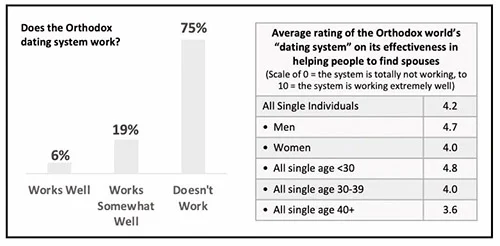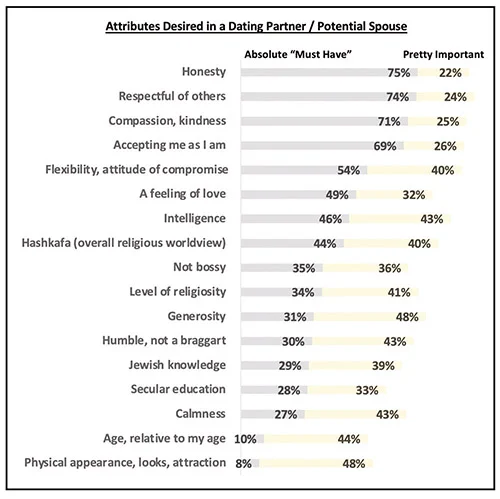
In the course of our communal research, we often hear concerns about the “shidduch (matchmaking) crisis.” In a nutshell, this refers to the widespread belief that an increasing number of marriage-minded frum singles are not getting married, with the result that many experience personal sadness, and often a weakening of their connection to the Orthodox community. What is this crisis, and what is causing it?
It is not our aim to detail or trace the evolution of today’s Orthodox matchmaking and dating systems, which reflect both sociological factors and halachic interpretations. Rather, we will explore whether the system is working and what changes might be worthy of consideration.
Our recent survey of 335 Orthodox single individuals explored how they view and rate the effectiveness of the “Orthodox dating system.” Perhaps the most jarring finding in this survey was the extent to which singles view the current system as a failure. As shown in the following table[1], three-fourths said the system doesn’t work and, on a 0-to-10 rating scale, the dating system got an average rating of 4.2 among single individuals on its effectiveness in helping people to find spouses—an abysmally poor rating. Of course, singles have not yet succeeded in finding a spouse, so a low rating might not be surprising; but note the nearly-as-bad 5.0 rating of the dating system by married respondents.
No system is perfect, and many people are finding their bashert and are happily married; for some, the system works from a utilitarian perspective. On the other hand, the number and intensity of the feelings of single individuals pose a communal issue that needs to be examined. Given these very poor ratings by single individuals as well as those married, it is clear that some sort of “shidduch crisis” does exist.

Is It a Demographic Issue?
We often hear from women that it’s hard to “find a guy” because there are fewer single men than women. With an overall population mix close to 50/50, and a mix among currently married couples of 50/50, why should there be a mismatch among singles? There are widows and widowers, but the demographic complaints are often heard from women in their 30s and 40s. There are a few theories.
One theory is that more men leave the community. While there are no data to support (or refute) this, anecdotes suggest it might have some––but probably not large––impact. Another theory is that there are more women baalei teshuva (those who became Orthodox as adults). Again, there is no solid evidence, and our 2019 survey of about 1,800 Modern Orthodox Jews found no significant gender difference in the incidence of baalei teshuva.
A more complicated theory points to a combination of the community’s large growth rate and the age gap between men and women.[2] The mathematics behind makes some sense as a possible contributing factor in the haredi world—but not so much among Modern Orthodox.
Is the Issue More “Quality” Than Quantity?
As the findings seem to point beyond the numbers, it behooves us to examine other potential factors. In discussions with women, it became clear that the complaints are not strictly numeric but relate to the quality of potential dating partners.
I recently spoke with David Katzoff, a volunteer matchmaker who has been active in assisting the Modern Orthodox singles community for the past 25 years. He shared a few observations, based on his many interactions with singles and other shadchanim. While Katzoff does believe that more men are “going off the derech” and there are more women baalei teshuva, he sees the larger problem as the fact that “there are simply not enough Jewish single men to go around who fit the qualities of what most Jewish single women are seeking in a spouse.” He continues, “There are many more men than women who are either very socially challenged, don’t have a firm career path, enjoy being single, or have a fear of commitment.” Additionally, he notes that there are “many more single men than women who will reject most suggested dating ideas to them based on the other’s physical appearance.”
I also raised the issue with an educator/therapist who has worked with hundreds of young adults over the past two decades. He is reluctant to generally place “blame” on men, noting that both men and women come in all levels of maturity and readiness for marriage. There may well be roles for educational and community institutions to get both young men and women more ready for marriage. However, he expressed more concern with “an excessive level of pickiness” due to the evaluation of potential mates based on a large list of factors outside of personal interaction.
Is the Shidduch System Promoting Excessive Pickiness?
Our survey provides data to help us explore this issue. As shown in the graph below,[3] out of a list of 27 criteria that people might look for in a dating partner/potential spouse, more than half of the respondents listed 17 of the criteria as either “absolute must haves” or “pretty important.” Furthermore, eight criteria were cited as “absolutely must haves” by 40% or more.
We found some differences between what men look for and what women look for. Men more often look for physical appearance (67% view it as a “must have” or pretty important. Compared to 51% among women). This is consistent with previous research[4] on male vs. female dating preferences. Attributes valued more by women are personality-based: women more often look for someone who is generous, respectful, humble and not bossy.[5]
What is striking about these findings is that both men and women are pretty selective, and perhaps too much so. On average, women denoted 8.4 attributes as “absolutely must have” and men denoted 6.5 attributes. Sure, there are people who clearly have many of the desired attributes but, on the other hand, might too many people be setting the bar too high?
Shifting From Resumes and Investigations To Actual Face-to-Face Encounters
In our socially connected information age, it becomes too easy to gather “disqualifying” information—often unreliable, unfairly judgmental or nonsensical. Our dating processes seem to be reducing people to simple attribute checklists (e.g., “shidduch resumes” that are widely used, typically contain lengthy lists of references), often without personal interaction. All of this creates much angst as well as missed opportunities to meet people, thus exacerbating the issue.
When we combine unrealistic expectations with a flood of questionable judgmental information, the unsatisfactory success rate is understandable. The good news is that research[6] shows that even brief personal interactions modify perceptions. After a face-to-face meeting, the “checklist” of expectations often becomes more realistic.
Some Conclusions
The kehillah is telling us that there are benefits to the current system—many people are indeed finding their mates—but there are too many negatives. The system could potentially be doing much harm, sociologically and emotionally. We offer two recommendations:
(1) First, given the survey verbatim responses and other feedback suggesting that too many young people are not ready to move toward marriage (facing social challenges, fear of commitment and direction, etc.), there may be a role for our high schools, Jewish colleges and shuls, as well as individual Orthodox leaders to play. The objective should be to create programs specifically aimed at getting our young men and women more prepared for this, in terms of knowledge, expectations and emotional maturity.
(2) Research has shown that adjusting the way people meet[7] and interact can have a significant impact on how people perceive potential mates, and therefore, it is likely that making research-based adjustments to the shidduch system will yield valuable improvements—both practically and psychologically. We need to shift from the “pre-meeting checklists” toward more face-to-face interactions. We do recognize that the Orthodox community is diverse, and some approaches will appeal differently to Modern Orthodox as compared to haredi/yeshivish. Consequently, ideas/solutions will vary depending on the existing processes, religious perspectives and sociological factors.
[1] Nishma Research, “Orthodox Jewry: Community, Connection, Understanding & Orthodox Jewish Singles,” May 2022. http://nishmaresearch.com/social-research.html, page 27
[2] Birger, Jon, “Date-onomics: How Dating Became a Lopsided Numbers Game,” 2015. Chapter 4 Sex Ratios, pages 44-73
[3] Nishma Research, Op. Cit. page 19.
[4] Fisman et al, “Gender Differences in Mate Selection: Evidence From a Speed Dating Experiment Get access Arrow,” The Quarterly Journal of Economics, May 2006, Pages 673–697, https://doi.org/10.1162/qjec.2006.121.2.673
[5] Nishma Research, Op. Cit. page 19.
[6] Dix, Andrew Clayton, “Impression Rating via Speed-Dating: How A Single Communication Event Can Alter Perceptions of Another Individual.” University of Southern Mississippi, Spring 2012. https://aquila.usm.edu/cgi/viewcontent.cgi?article=1568&context=dissertations
[7] Kaplan, Matt, “Role reversal undermines speed-dating theories,” Nature, June 2009.













